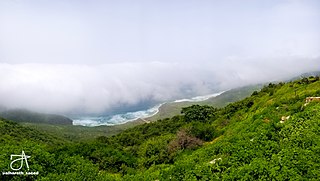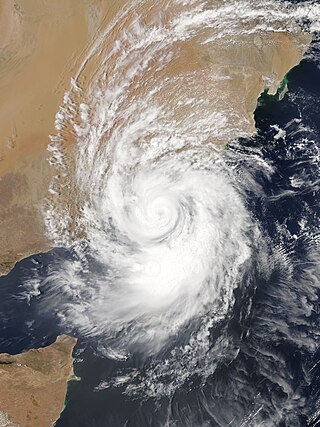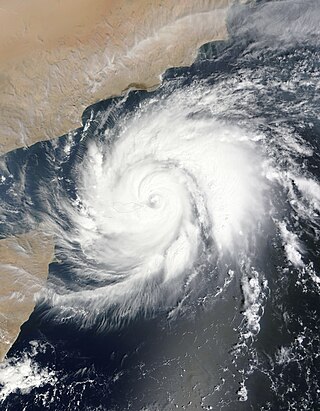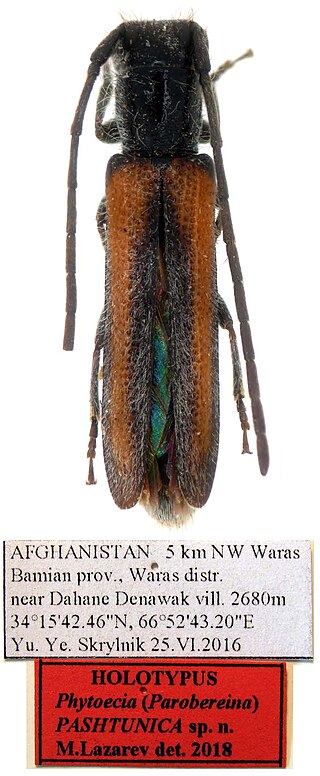Related Research Articles

Oman is a country on the southeast coast of the Arabian Peninsula, situated in West Asia, bordering the Arabian Sea, Gulf of Oman, and Persian Gulf, between Yemen and the United Arab Emirates (UAE). The coast of Oman was an important part in the Omani empire and sultanate.

The Dhofar Governorate is the largest of the 11 governorates in the Sultanate of Oman in terms of area. It lies in southern Oman, on the eastern border with Yemen's Al Mahrah Governorate and the southern border with Saudi Arabia's Eastern Province. It is a rather mountainous area that covers 99,300 km2 (38,300 sq mi) and had a population of 416,458 at the 2020 census. The largest city and capital is Salalah. Historically, the region was a source of frankincense. The local dialect of Arabic is Dhofari Arabic, which is distinct from that used in the rest of Oman and in Yemen.

Salalah is the capital and largest city of the southern Omani governorate of Dhofar. At the 2020 census, it had a population of 331,949.

Al Mahrah, or simply Mahra, is a governorate (muhafazah) of Yemen in the southern part of the Arabian Peninsula. Situated in the area of the former Mahra Sultanate, its capital is Al Ghaydah. It has international borders with Oman.

The Dhofar War took place from 1963 to 1976 in the province of Dhofar against the Sultanate of Muscat and Oman. The war began with the formation of the Dhofar Liberation Front, a Marxist group which aimed to create an independent state in Dhofar, free from the rule of the Omani Sultan Said bin Taimur. The rebels also held the broader goals of Arab nationalism which included ending British influence in the Persian Gulf region. Omani and British goals, on the other hand, were to safeguard Oman from communism and halt the spread of communist ideology as part of the broader Cold War.

Taqah is a province and coastal town in the Dhofar governorate, in southwestern Oman. It is located at about 17°2′14″N54°24′13″E. The nature of the Taqah wilayat is diverse, as it is a coastal province with beaches, plains, and mountains. It is also known for the presence of caves, such as the caves of Taqah and the caves of Wadi Darbat. Additionally, Taqah has two inlets, Khawr Taqah and Khawr Rawri, both declared as protected areas within the Alkhawr Coastal Nature Reserves by virtue of Royal Decree No. 49/97. The wilayat also features the springs of Ain Khawr Taqah and Ain Darbat, known for their waterfalls."

Hawf District is a district of the Al Mahrah Governorate, Yemen. As of 2003, the district had a population of 5,143 inhabitants. The Hawf Area was nominated to be a natural UNESCO World Heritage Site in August 2002. Currently, it is listed as a tentative World Heritage Site. It's around 2 hours away from Sultanate of Oman border and it is 180 km away from Salalah, that is one of the biggest cities of Oman.
Kartlayt is a village in Dhofar Governorate, in southwestern Oman. Salalah (Şalālah), capital of Dhofar, is approximately 41 km / 25 mi away.

Jordanoleiopus is a genus of beetles in the family Cerambycidae, containing the following species:

The 1996 Oman cyclone was a tenacious and deadly system that caused historic flooding in the southern Arabian Peninsula. It originated from a disturbance in the Gulf of Aden, the first such tropical cyclogenesis on record. After moving eastward, the system interacted with the monsoon trough and became a tropical storm on June 11. Later that day, it turned toward Oman and struck the country's southeast coast. It weakened over land, dissipating on June 12, although it continued to produce rainfall – heavy at times – over the next few days.

The wildlife of Oman is the flora and fauna of this country in the southeastern corner of the Arabian Peninsula, with coasts on the Gulf of Oman and the Arabian Sea. The climate is hot and dry, apart from the southeastern coast, and the country offers a variety of habitats for wildlife including mountains, valleys, deserts, coastal plains and sea coasts.
Dorcadion sisianense is a species of beetle in the family Cerambycidae. It was described by Lazarev in 2009. It is known from Armenia.

Extremely Severe Cyclonic Storm Mekunu was the strongest storm to strike Oman's Dhofar Governorate since 1959. The second named storm of the 2018 North Indian Ocean cyclone season, Mekunu developed out of a low-pressure area on May 21. It gradually intensified, passing east of Socotra on May 23 as a very intense tropical cyclone. On May 25, Mekunu reached its peak intensity. The India Meteorological Department estimated 10 minute sustained winds of 175 km/h (110 mph), making Mekunu an extremely severe cyclonic storm. The American-based Joint Typhoon Warning Center estimated slightly higher 1 minute winds of 185 km/h (115 mph). While at peak intensity, Mekunu made landfall near Raysut, Oman, on May 25. The storm rapidly weakened over land, dissipating on May 27.

The Dhofar Mountains are a mountain range in the southeastern part of the Arabian Peninsula. In a broad sense, they extend from Dhofar Governorate in Oman to Hadhramaut Governorate in Yemen, and are located between the Hajar in the northern part of Oman, and the Sarawat in the western part of Yemen. Otherwise, the range in the eastern part of Yemen, particularly near Mukalla, is referred to as the Hadhramaut or "Mahrat".
Muqshin is a Wilayat of Dhofar in the Sultanate of Oman. It is located in the northeastern corner of the Dhofar Governorate, on the southeastern outskirts of the Empty Quarter desert, adjacent to the international border with the Kingdom of Saudi Arabia. It is 345 kilometers away from the city of Salalah and is connected to the main asphalt road that connects the Dhofar Governorate to the rest of the Sultanate’s regions.
The COVID-19 pandemic in Oman was a part of the worldwide pandemic of coronavirus disease 2019 caused by severe acute respiratory syndrome coronavirus 2. The virus was confirmed to have reached Oman on 24 February 2020 when two citizens tested positive for COVID-19 after returning from Iran. As of 21 August 2021, the total number of cases registered in the sultanate is 300,914, of which 289,450 have recovered and 4,020 have died. Initially, the majority of the cases and deaths occurred in the expatriate community. By July 2020, as the pandemic entered its fourth month in the country, the majority of the cases and deaths had occurred among the citizens.

Extremely Severe Cyclonic Storm Tej was a strong tropical cyclone that formed over the central-south Arabian Sea and made landfall on Yemen. It was the first cyclone to make landfall in the nation since Cyclone Luban of 2018. The sixth depression and the third named cyclonic storm of the season, Tej coexisted with Cyclone Hamoon in the Bay of Bengal, a rare phenomenon not seen since 2018. The cyclone then took a northwestward track in the Arabian Sea and made landfall in Al Mahrah Governorate of Yemen between 23 and 24 October 2023, bringing significant rainfall and flooding across the eastern half of the country and western parts of Oman.

Phytoecia (Parobereina) pashtunica is a species of beetle in the family Cerambycidae. It was described by Lazarev in 2019. It is known from Afghanistan.
Calchaenesthes ambrusi is a species of beetle in the family Cerambycidae. It was described by Lazarev in 2023. It is known from Cyprus.
Dorcadion (Cribridorcadion) paramicans paramicans is a species of beetle in the family Cerambycidae. It was described by Lazarev in 2016. It is known from Turkey.
References
- ↑ BioLib.cz - Jordanoleiopus (Polymistoleiopus) annae.
- ↑ Lazarev M.A. & Skrylnyk Y.E. 2023. A new species of the genus JordanoleiopusLepesme & Breuning, 1955 (Coleoptera, Cerambycidae) from Oman. Humanity space. International almanac . Volume 12. No 2: 137–147. doi : 10.24412/2226-0773-2023-12-2-137-147.